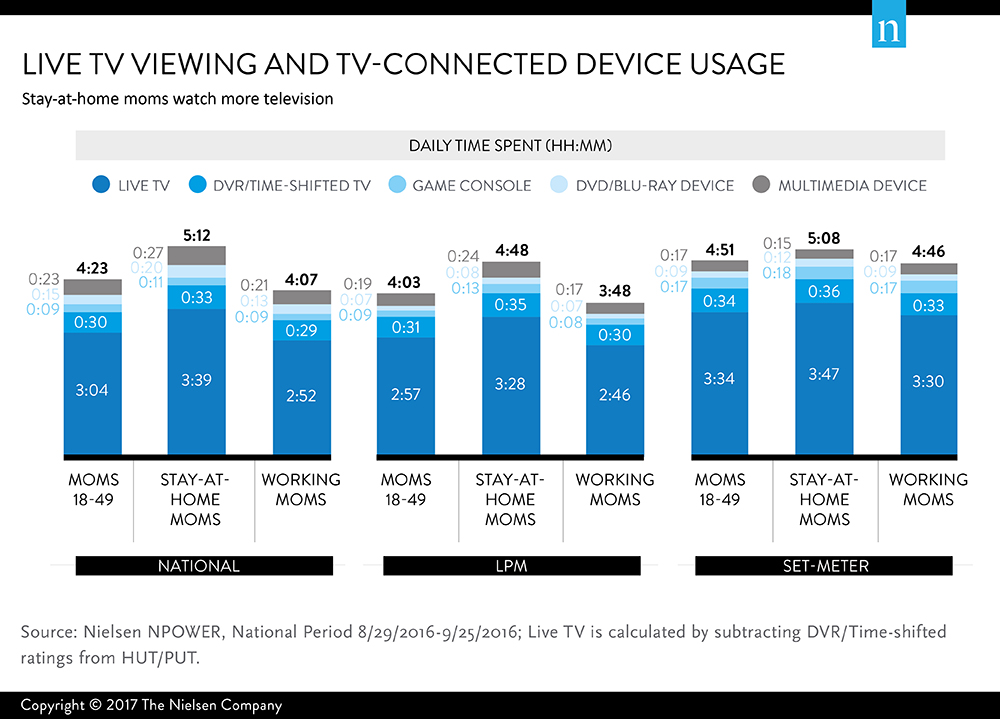Mothers are at the epicenter of the family circle and are always ahead of the game, often balancing motherhood, work and most importantly, life. But what does this look like across the country’s many local communities, and how are stay-at-home and working moms adapting to technology and using media?
Local News Is Key to Reach Mothers
According to the latest Local Watch Report, 26% of the country’s 25.1 million moms are stay-at-home moms, and roughly three-fourths are working moms. Women between age 18-24 account for the highest percentage of stay-at-home moms, at 34%. On-the-other-hand, 78% of working moms are found among women age 40-44.
Let’s take a deeper look at the concentration of stay-at-home and working moms and where they live—in 25 of the top TV metered markets* and 31 mid-size metered markets**.
In all metered markets, 75% of moms are employed. Nashville, Tulsa and Los Angeles have the highest percentages of stay-at-home moms at over 36%, while Providence, R.I., has the highest percentage of working moms at 87%, followed by Milwaukee, Wis., and Knoxville, Tenn., at 85% each.
But even though the percentages of working and stay-at-home mothers are similar across these markets, these moms don’t interact with media in the same way. And that means advertisers need to understand the best ways to reach them.
So, what’s the best time to reach moms via local news?
Well, it all depends on if they’re working or stay-at-home moms. Since they have different schedules, their local news consumption differs based on where they are during the day.
According to the report, working moms watch more early morning and late news than stay-at-home moms, as they’re mostly working during the daytime. Comparatively, stay-at-home moms watch more mid-day and early evening news and spend much less time tuning into local news in the morning.
For stay-at-home moms, St. Louis tops the charts in average news ratings for early evening and late news, with average ratings on 2.45 and 3.21, respectively. As for working moms, Pittsburgh wins in both morning and late news, with average ratings of 2.05 and 2.92, respectively.
Moms and Device Usage
Understanding moms’ device usage (i.e., over-the-top devices, video game consoles, DVDs, etc.) is also important for advertisers, particularly as TV-connected usage increases. When looking at trends in live TV and TV connected device usage in metered markets, we see that stay-at-home moms spend the most time with both live and connected TV content.
Stay-at-home and working moms in mid-size markets watch more live and connected TV content than the national average and the average of top 25 TV markets. When we look at TV consumption across metered markets, we see that mothers in mid-size markets spend nearly an hour (58 minutes) more per day engaged with live TV and TV connected devices that mothers in the top 25 TV markets.
Regardless of market, all moms have one thing in common: live TV is their top choice to view content daily with more than two hours and 46 minutes, followed by time-shifted viewing, with 30-36 minutes per day.

Now, let’s take a look at the media consumption behavior of moms at a market level.
Across the 56 metered U.S. TV markets, stay-at-home moms in Providence spend the most time with live TV (seven hours and 40 minutes per day), followed by Detroit (seven hours and 32 minutes per day).
Although working moms spend less time viewing live TV in both top and mid-size markets, they spend the most time tuning in live in Birmingham, Memphis and New Orleans. Across all metered markets, stay-at-home moms in Portland spend the most time with TV-connected devices, at two hours and 26 minutes spent daily. Stay-at-home moms in San Francisco are at the opposite end of the spectrum, as they only spend 42 minutes a day with connected devices.
Whether they’re working or staying at home, moms are an influential part of the family tree and play an active and powerful role within local economies. They’re also adapting to the new media landscape by using new forms of technologies, which amplifies the need for marketers to know how and where to reach them.
For additional insight, download the latest Local Watch Report.
Notes
*Nielsen Local People Meter markets comprise 25 of the top television markets in the U.S.**Nielsen Set-Meter markets comprise 31 mid-sized markets in the U.S.



